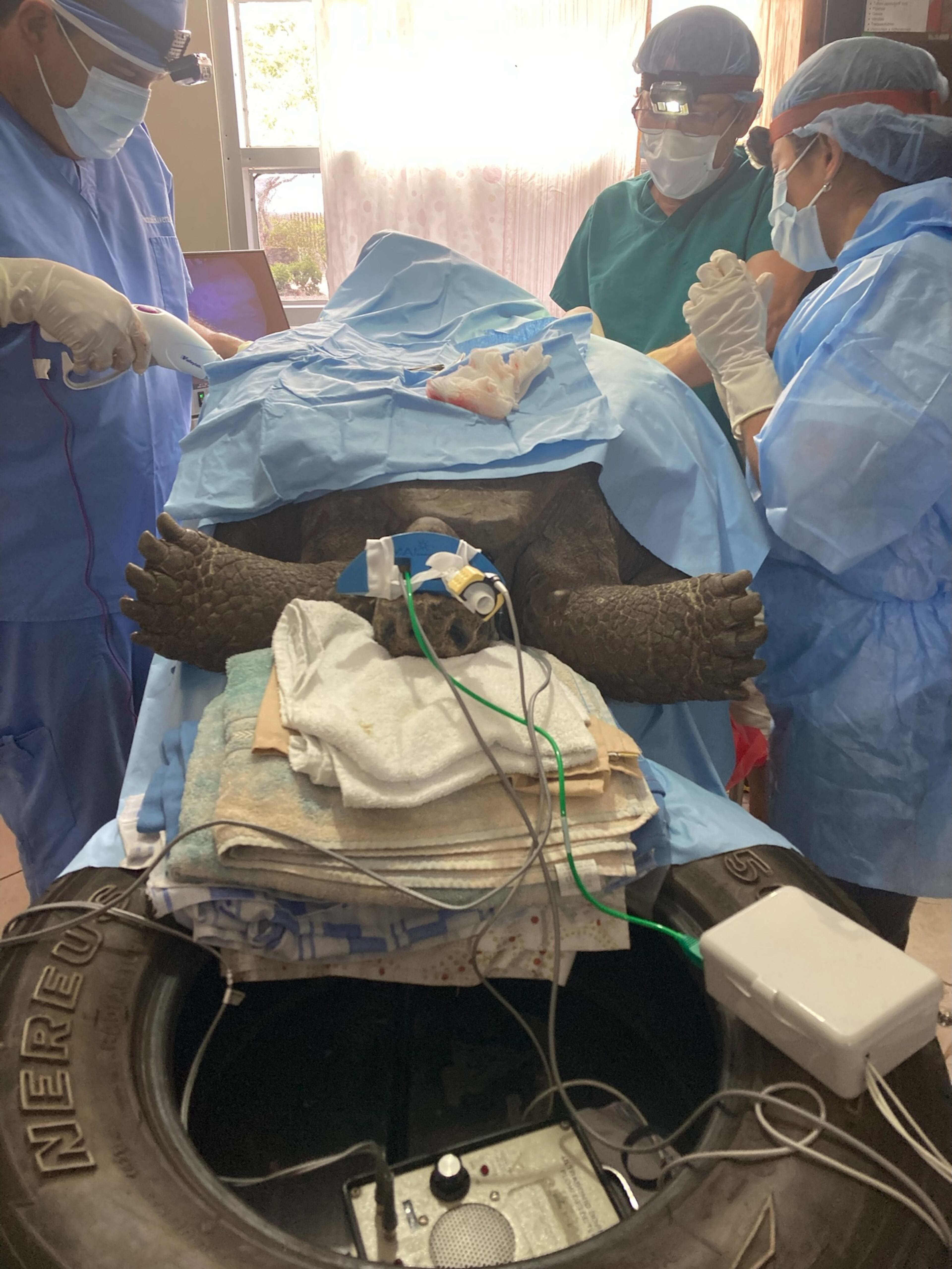Georgia’s Galápagos connection

Weighing more than 500 pounds and with an average life span exceeding a century, the Galápagos giant tortoise — once one of nature’s most enduring animals — is now one of its most endangered.
Found only in the Galápagos Islands in Ecuador, these reptiles once represented over a dozen subspecies unique to each island, some of which have become extinct. The Charles Darwin Research Station on the archipelago’s island of Santa Cruz houses many of the remaining species in its breeding facility in hopes of reviving the remaining populations.
Considering the tremendous efforts underway to save the Galápagos giant tortoise from extinction, it was a curious set of circumstances that found two esteemed veterinarians from Georgia 2,400 miles from home in Galápagos in 2009 and again in 2022, performing operations to sterilize the prehistoric creatures.

Messing with Mother Nature
Over time, Galápagos giant tortoises evolved into more than a dozen different subspecies based on the unique ecology of each island habitat, meaning that the tortoises native to Santa Cruz Island are genetically different from those on Pinta Island.
When goats were introduced to Pinta Island in the 18th century, it created an ecological disaster for the tortoises living there. The goats multiplied into the tens of thousands, overtaking the giant tortoise as the dominant herbivore. An aerial survey conducted in the 1970s found only a single giant tortoise still living on the island. He was named Lonesome George.
“It’s tragic really; they didn’t understand what was happening until it was too late. They airlifted Lonesome George off to Santa Cruz and tried to breed him,” said Dr. Stephen Divers, zoological professor at the University of Georgia’s College of Veterinary Medicine.
Meanwhile, goats were slowly eradicated from the island over the course of decades, and eventually Pinta Island no longer had a large herbivore to control overgrowth.
“We ended up with this very abnormal ecological situation,” Divers said. “It became urgent to reestablish a population of giant tortoises on that island to engineer a more balanced ecological recovery.”
The Charles Darwin Research Station spent decades attempting to restore tortoise populations through captive breeding programs, though initially they were unaware that the giant tortoises had unique subspecies.
“They were busy trying to breed tortoises and so they [unknowingly] produced this mixed genetic population, which they then realized they couldn’t release,” said Divers.
Although many tortoises at the Charles Darwin Research Station are bred for the purpose of rewilding, they did not want these cross-species tortoises to reproduce.
Hybrid tortoises have limited conservation value in captivity, but theoretically could act as ideal habitat engineers for Pinta Island. The challenge was preventing them from potentially breeding once they were introduced to the island.
Enter Divers, Dr. Sam Rivera, Zoo Atlanta’s vice president of animal health, and Dr. Joe Flanagan, chief veterinarian at the Houston Zoo.

Rivera’s personal and professional dream was to one day work with Galápagos tortoises, so he needed no convincing to join Divers and Flanagan in the Enchanted Isles.
“When this opportunity came up, I said yes before I knew the details,” Rivera said. “I’m going to the Galápagos to work with giant tortoises? Sign me up.”
Zoo Atlanta lacks the space to house a giant tortoise, but its team of veterinarians have extensive knowledge, resources and experience performing surgeries on turtles, tortoises and other reptiles.
Working with additional endoscopists and veterinarians from Ecuador, Georgia and Texas, the team had to first determine if sterilization was even possible, which meant speculating on what equipment was necessary for an animal of this size and structure.
“We had to triple check to make sure we brought everything we needed because we weren’t going to get replacements,” Rivera said. “It’s not like a dog or a cat where you can go in the abdomen; we needed to bring special endoscopy equipment.”
Rivera noted that anesthetizing giant reptiles is inherently difficult. Even though they’ve worked with Aldabra giant tortoises at Zoo Atlanta, the increased weight and size of a Galápagos tortoise created obstacles that prevented them from using certain anesthesia methods.
Rivera explained that the spinal cord of a Galápagos giant tortoise extends into its tail. They could inject an anesthetic into the spinal canal to numb the lower half of the body without the animal losing consciousness, similar to a local anesthetic. It was the first documented account of a successful spinal anesthesia in any tortoise or turtle species.
Over the course of 10 days in 2009, 45 male and female tortoises were operated on resulting in one postoperative female death. The veterinarians returned again in 2022 and sterilized 49 more with two female postoperative fatalities.
“This was kind of breaking new ground surgically, endoscopically, conservationally and anesthetically. It’s quite impressive; probably one of the best projects I’ve been involved with,” said Divers.
“Not many of us get the opportunity to do something that has such a long-lasting impact,” Rivera added. “I’ve been very fortunate and most proud of the fact that I’m learning things here in Georgia that I’ve applied in the Galápagos to help species conservation.”

Conservation closer to home
In 2012, three years after Divers and Rivera performed their first tortoise sterilizations, Lonesome George died, marking the extinction of his subspecies. His embalmed body is on display at the Charles Darwin Research Station, a representation of how decisions made decades ago triggered a domino effect leading to the extinction of a subspecies.
Rivera hopes that the decisions made across the last two decades can improve the population rates of the remaining subspecies, as well as tortoises and turtles around the globe.
While Rivera and Divers acknowledge the vital importance of Galápagos conservation, they also encourage a deeper look into Georgia’s own ecological needs.
“It’s fascinating when we talk about going to other countries,” Rivera said. “But when you look at our own backyards, there’s so much work that needs to be done and so much that we still don’t know.”
Divers echoed Rivera. “We have our own native species that warrant our attention in Georgia,” he said. That includes the Eastern box turtle, the Barbour’s map turtle and the Suwanee alligator snapping turtle, species considered at risk on the International Union for Conservation of Nature Red List, which assesses the world’s biodiversity health.
Local conservation efforts include a partnership between Zoo Atlanta and the Georgia Sea Turtle Center in Jekyll Island to bolster the diamondback terrapin population. In the spring, females crossing roadways in wetland areas to lay eggs on dry land are often struck and killed by motorists. When possible, their eggs are harvested and Zoo Atlanta rears the hatchlings until summer when the Georgia Sea Turtle Center releases them into the ocean. Visitors can participate in hatchling releases with advance reservations.
And this spring, eight loggerhead sea turtles found cold-stunned in icy New England waters were released on Jekyll Island after being nursed back to health at the Georgia Aquarium. Over the past five years, the facility has treated 44 cold-stunned loggerhead sea turtles.


